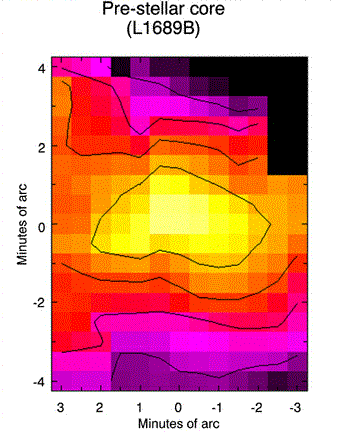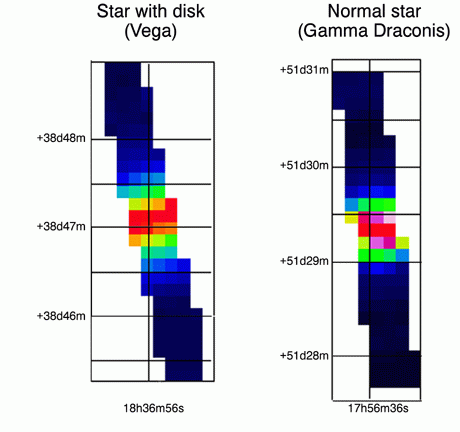
An ISOHOT 160 micron image of the the Pre-stellar core L1689B
(Hi-Res: Postscript)
The first infrared image ever obtained of a pre-stellar core shows the egg-like object from which a new star will form. It illustrates ISO's role in tracing the earliest stages of star formation. Pre-stellar cores are very cold, and remain hidden by dust from all telescopes except those working with very short radio waves and long infrared waves. Within a core, gravity squeezes gas and dust towards the centre to make an embryonic star, but by the time other instruments can see what's happening the star-making processes are far advanced. The object L1689B is judged to be on the very brink of collapsing under gravity, to begin to form a star.
Observing at sub-millimetre wavelengths British and French astronomers
had detected L1689B as small, dense, features within a much larger cloud
of gas and dust located in the constellation Ophiuchus. Scans by ISO's
photometer, ISOPHOT, at various wavelengths up to its limit of 200 microns,
now give different impressions of L1689B and enable the astronomers to
measure the temperature of the pre-stellar core at about minus 260 degrees
C (13 K). The image is colour-coded for intensity, with the bright core in
yellow-white.

Vega and Gamma Draconis: surrounding disk
Also from ISOPHOT on ISO comes the latest measurement of the size of an infrared-emitting disk of dust that surrounds the bright star Vega. When detected in 1983 by the US-Dutch-UK Infrared Astronomy Satellite IRAS, this dust disk excited astronomers because it matched their ideas about the surroundings of the Sun at the time when the planets of the Solar System were being born. The ISO scan of Vega offers the latest measurement of the radius of the Vega disk. It is between 80 and 140 times the distance of the Earth from the Sun, and the edge of the disk may stretch as far as 400 times the Earth-Sun distance. For comparison, Neptune, the most distant large planet in the Solar System, is at 30 times the Earth-Sun distance.
A corresponding scan across the star Gamma Draconis, used as a control specimen, shows no dust disk. The infrared emissions are concentrated on the visible star and they are very bright on the ISOPHOT detector, but the peak brightness is restricted to a thin strip in the middle of the scan, unlike Vega. In both of the colour-coded images, red denotes the strongest emissions from the source.
Credits:
These images are dicussed in the item "ISO searches for the origins of stars and planets" that appeared in the ESA/ISO Info Note 25.97. Other images from this note can be viewed here
 Return to the Introduction Page
Return to the Introduction Page